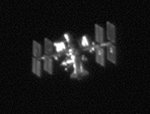G
How to prove beyond-a-shadow-of-a-doubt that the Earth is flat, and not a sphere...
Position, somewhere on the Equator, a stationary reference "beacon" that sends out a signal in all directions -- or, at least - either East or West - with an angular range from North to South ( i.e. - 180 degrees with East / West in center - albeit, only the North 90 degrees will be significant ).
Position, on a ship / airplane, a directional receiver - such that, it can be determined with sufficient accuracy the angle ( relative to the Equator - or, directly behind ship / airplane ) the reference beacon is being detected.
Using a directional transmitter-receiver at both points would be even better.
Make sure that the signal - of whatever type - is of sufficient strength to reach a very long distance - and cannot be "blocked" by anything that might happen to come between the reference beacon and the ship / airplane.
As the ship / airplane moves away from the beacon, while staying on the equator:
~ If the Earth is a sphere, the signal will be lost soon enough because of the curvature of the earth; however, the angle from reference will never waiver from 0 degrees -- the beacon will always be directly behind the ship / airplane.
~ If the Earth is flat, the signal will be sustained for whatever distance it is capable of being detected; and, the detection angle will increase with the distance between the reference beacon and the ship / airplane.
Why? Because the ship / airplane will actually be following a circular path over the face of the Earth.
This will only work on the Equator - because, from a perspective regarding the angular part of the above suggested experiment - it is the only lattitude that is supposed to be a continual straight line all the way around the globe. And, that is why - if the results of the latter case are obtained - the Earth cannot possibly be a sphere.

Position, somewhere on the Equator, a stationary reference "beacon" that sends out a signal in all directions -- or, at least - either East or West - with an angular range from North to South ( i.e. - 180 degrees with East / West in center - albeit, only the North 90 degrees will be significant ).
Position, on a ship / airplane, a directional receiver - such that, it can be determined with sufficient accuracy the angle ( relative to the Equator - or, directly behind ship / airplane ) the reference beacon is being detected.
Using a directional transmitter-receiver at both points would be even better.
Make sure that the signal - of whatever type - is of sufficient strength to reach a very long distance - and cannot be "blocked" by anything that might happen to come between the reference beacon and the ship / airplane.
As the ship / airplane moves away from the beacon, while staying on the equator:
~ If the Earth is a sphere, the signal will be lost soon enough because of the curvature of the earth; however, the angle from reference will never waiver from 0 degrees -- the beacon will always be directly behind the ship / airplane.
~ If the Earth is flat, the signal will be sustained for whatever distance it is capable of being detected; and, the detection angle will increase with the distance between the reference beacon and the ship / airplane.
Why? Because the ship / airplane will actually be following a circular path over the face of the Earth.
This will only work on the Equator - because, from a perspective regarding the angular part of the above suggested experiment - it is the only lattitude that is supposed to be a continual straight line all the way around the globe. And, that is why - if the results of the latter case are obtained - the Earth cannot possibly be a sphere.
-
1
- Show all



